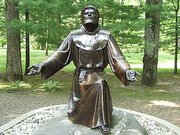Dowry of Our Lady
 ‘Our Lady’s dowry’. This used to be the description that England applied to itself and that other countries also used of the country that had dedicated itself to Our Blessed Mother. That is why the Feast of Our Lady of Walsingham, celebrated in England on 24th September, is so important: it recalls a time when, throughout the land, there were shrines dedicated to Our Lady. Every county had its own place of pilgrimage in her honour. Even today, the shrine of Our Lady of Walsingham is also known as ‘England’s Nazareth’.
‘Our Lady’s dowry’. This used to be the description that England applied to itself and that other countries also used of the country that had dedicated itself to Our Blessed Mother. That is why the Feast of Our Lady of Walsingham, celebrated in England on 24th September, is so important: it recalls a time when, throughout the land, there were shrines dedicated to Our Lady. Every county had its own place of pilgrimage in her honour. Even today, the shrine of Our Lady of Walsingham is also known as ‘England’s Nazareth’.The feast of Our Lady of Walsingham dates back to 1061, before the Norman Conquest, when Mary appeared in a vision to Richeldis de Faverches, a devout Saxon noblewoman, in 1061 in the Norfolk village of Walsingham. Richeldis was asked to build a wooden replica of the house in Nazareth in which the Annunciation took place. Today, after more than 1000 years, archaeologists have discovered the approximate location of that little shrine which became, not only a place of national pilgrimage, especially during the times of the Crusades when travelling to Rome, the Holy Land and Compostella were highly dangerous, but also the world’s third most important Catholic shrine. Records still exist of the visits of seven English kings, including (perhaps surprisingly) Henry VIII, who also ordered its destruction in 1538.
The original statue of Our Lady of Walsingham was burnt in a bonfire in London, but enough miniatures remained for us to know that Mary was seated on a throne, wearing a simple Saxon crown, carrying a lily in her right hand and bearing Jesus, also wearing a crown, on her knee. This was sufficient to reconstruct the familiar image seen today, commissioned in honour of the declaration of the Dogma of the Assumption in 1950, ‘solemnly crowned near the site of the original Shrine on behalf of Pope Pius XII by his Apostolic Delegate’ and installed in the Slipper Chapel in 1954.
‘Our Lady, as she is venerated at Walsingham, is depicted as a simple woman, a mother. She is seated on the throne of Wisdom, in the midst of the Church which is represented by the two pillars symbolic of the Gate of Heaven, with seven rings to signify the seven sacraments and the seven gifts of the Holy Spirit. The arched back of the throne reminds us of the rainbow which was set as a sign of God’s fidelity to his creation. Our Lady is clothed in the blue of divinity, the white of motherhood and the red of virginity. In her hand she holds a lily-sceptre with three blooms because she was virginal before, during and after the Saviour’s birth. As the Woman of the New Creation, the New Eve, she crushes beneath her feet a toadstone, symbolic of the power of evil. As the Queen of Heaven and of England, her Dowry, she is crowned with a Saxon crown. On his mother’s knee is the child Jesus who, as the Word of God made Flesh, holds the book of the Gospels. He extends his right arm in a double gesture of blessing and protection of his mother.’
Exquisitely, the shrine of Our Lady of Walsingham is, yet again, a symbol of unity, where Anglicans, as well as Catholics venerate our mother, all of us praying for the day when Mary will, once again, be our Queen, bringing us together in her Son. The tradition has never died out that it is through praying to Our Lady of Walsingham, that unity will be restored. As the hymn says: ‘Be England thy dowry as in days of yore.’
God bless,
Sr Janet

